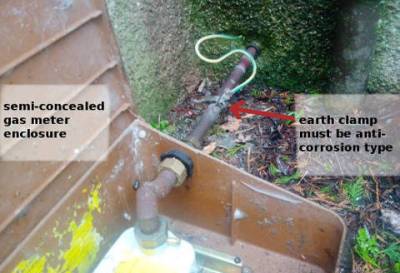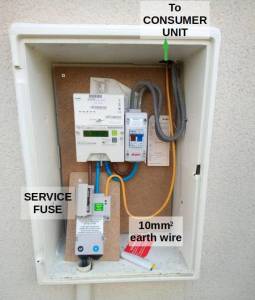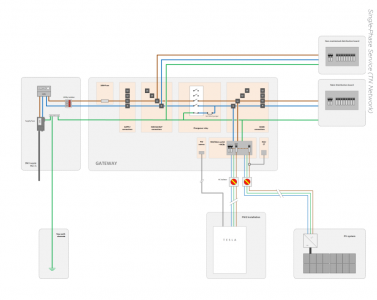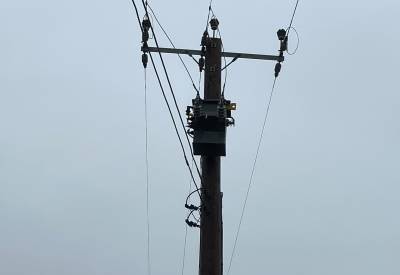Earth Bonding
Earth Bonding.
I have recently had my gas meter removed by Octopus Energy (no more gas standing charges!) as we are now all-electric. When OE took the meter out, they fitted an earth strap across the still existing gas inlet point where it terminates with the valve and the other end was fitted to the gas inlet pipe to the house. I am wondering if I need to keep this bond - OE put the link in to be sure, to be sure. I have the DNO’s earth bond on the electrical feed to the house meter and also a 4 foot stake driven into the ground with heavy gauge strap fitted to the solar PV and Powerwall installation. Is there likely to be any good reason to maintain this old gas pipe earth bond any more please? Regards, Toodles.
Toodles, heats his home with cold draughts and cooks food with magnets.
Earthing is a tricky subject to tackle on a Forum, especially when we don't have access to all of the site information.
Let me try and unpick a number of points from what you've posted.
1: Protective Equipotential Bonding (PEB) of an incoming gas pipe is covered within the IET and Building regulations.
If the service pipe to the gas meter is conductive, then there must be a earthing connection clamped to the gas pipe within 600mm of the point where it enters the house.
The other end of that 10mm² PEB wire is terminated at the same point in the house from which the electricity circuits derive their earth connection, which is almost always within the consumer unit (or fuse box).
2: You do not say whether your gas meter was internal or external to the house.
Nor have you indicated whether it did indeed have the mandatory PEB clamped to the gas pipe in the required location.
3: A gas pipe is still regarded as a gas pipe if the meter is removed.
4: To maintain earth continuity between two gas pipes which were originally connected via a meter, an earth-link is installed.
As it connects to the incoming service pipe, it is not your property and may not be disturbed or removed.
The gas meter engineer is not authorised to check the pipe continuity, or the material used for that pipe, elsewhere in the property.
With the absence of such knowledge, he/she will assume that the pipe is conductive throughout its run.
5: I don't understand why you mention a DNO's earth bond being connected to a meter.
Nor is it clear whether you are now referring to the electricity meter.
In any case, meters do not usually have any form of earthing wire connected to them.
6: If the house's electricity supply provides an earth, then it will usually emerge from the DNO's Service Fuse and be connected to the earth bar inside the consumer unit.
Such a supply is called PME.
If it runs overhead via poles, then each pole has a notice stating PME about 2m above ground level.
In that case, the incoming earth must not be also connected to a ground stake unless the DNO states otherwise.
7: An earth stake provided for either a solar panel array or an EV Charge Point is provided for safety whilst these are in operation.
In the majority of cases, that earthing is not connected to house earth in the electricity consumer unit.
An earth connection for PV panels delivers a path to ground in the unlikely event of the house receiving a direct lightning strike.
There may or may not anti-surge devices connected between this and the conductors bringing DC power off the roof to your string inverter.
An earth connection for an EV charge point at a house supplied by PME will prevent the metalwork of the car becoming 'live' in the event of a fault on the Neutral.
As you can see, this is a complex subject, and there are multiple ways in which earth connections can/must be made, depending on a wide range of circumstances.
If you need to ask for additional explanations, you are welcome to, but:
- you will need to be very clear which components you are referring to and their location
- there is a risk that someone else may read this topic and (incorrectly) assume that their situation is similar to yours. To avoid that I will either have to provide lengthy descriptions or else decline to elaborate further.
Save energy... recycle electrons!
Thank you Transparent and I should apologise for my sloppy writing. The gas meter pipework (minus the smart meter) is external on the front wall of the house; there is an earth cable attached to the ‘domestic’ side of this pipework (ie. on the pipe going underground and into the void under the house) which has one of the stamped metal tags about safety attached to it. The ‘live gas pipe does not appear to have any cable bonded to it above ground level. The electricity meter is about 6 metres away indoors under the stairs. The electrical supply cable rises from the void through the floor and an earth cable appears from this at the base of the master fuse. There are a number of earth cables all bonded together with a bus bar screwed to the wall again with safety label. Earth cables go to the consumer unit and also into the trunking that leads through to the garage where the solar PV and powerwall are connected up. As mentioned before, there is also the additional earthing rod out in the garden for the solar kit. By the way, the PV panels each have their own Enphase micro-inverters and the power comes down to the switches and then the Tesla Gateway at nominally 240 volts AC. Regards, Toodles.
Toodles, heats his home with cold draughts and cooks food with magnets.
Posted by: @toodlesEarth cables go to the consumer unit and also into the trunking that leads through to the garage where the solar PV and powerwall are connected up. As mentioned before, there is also the additional earthing rod out in the garden for the solar kit.
I'm happy that the Tesla storage battery system has an earth connection back to point beside the consumer unit.
I wouldn't be happy if there was any link between that Tesla earth wire and the stake in the garden.
If there was a broken Neutral wire in the DNO's cable in the road, then your earth-stake would be providing the Neutral reference point for houses beyond the break-point.
In practice this allows the metal casings of main appliances within those houses to 'float' at around 80vAC. That's unsafe for your neighbours.
Electricians who install LCT devices such as grid-tied battery storage, EV charge points and heat-pumps are trained to a higher level than those who undertake only household electrical installation.
That training is to alert them of just such compromises to safety when a fault occurs.
Save energy... recycle electrons!
@transparent don't wish to hijack the thread but please could you elaborate re "
Posted by: @transparentI wouldn't be happy if there was any link between that Tesla earth wire and the stake in the garden.
This diagram is from Powerwall installation manual
It shows a link between earth spike and the earth derived from the incoming neutral.
Background - had Powerwall installed a year or so ago - house is PME - installers did not fit an earth spike. My understanding is that without an earth spike then a broken main incoming cable to my house means my house isn't earthed even though it could be powered from the battery - faults in my house then become potentially lethal. I asked and installers fitted the earth spike wired as per the diagram above. We are supplied by overhead wires and power goes out a couple of times a year, - geese flying into wires, poles falling in high winds, trees bringing wires down, etc. I have little confidence in the installers but do have electrical certificate and G99 approval from National Grid.
Would like system to be safe (for everyone)!
Thanks
Our experiences with solar pv, ASHP, battery, and EV: ourhomeelectric.co.uk
I had a discussion on speakEV about exactly this a while back (ignore the bit at the start about the rolec, thats' gone, the latter part is a powerwall earthing discussion).
My powerwall setup is the exactly the same as toodles and steevjo - PME from the DNO cable, and a local earth rod added by the Tesla installer. I think they are all (Tesla PW installs) like this, as this is the same diagram I've seen before. My installs done by Tesla certified EVSE and Battery installers not "domestic only" sparks and I'm sure the others will be the same.
My octopus signup link https://share.octopus.energy/ebony-deer-230
210m2 house, Samsung 16kw Gen6 ASHP Self installed: Single circulation loop , PWM modulating pump.
My public ASHP stats: https://heatpumpmonitor.org/system/view?id=45
11.9kWp of PV
41kWh of Battery storage (3x Powerwall 2)
2x BEVs
The point you're raising @steevjo and @iancalderbank is extremely important.
As it's a safety issue, I'm going to look back at some diagrams and notes I made about earthing problems when OVO/Kaluza were first installing their V2G chargers.
Stand by... and I'll post again once I've refreshed my memory as to what fault conditions can and cannot be handled, depending on whether you have an earth stake and the 'correct' bonding.
And I'm going to tag @editor here to forewarn him that we're discussing a matter of safety legislation on an open forum.
Save energy... recycle electrons!
@transparent Thanks for taking the time.
Bit of extra info - when I finally received the G99 connection approval the confirmation letter included this para:
"The Customer's Generator will be run in Parallel mode only. The Customer shall take precautions to ensure that
the neutral of the Customer's Generator is not connected to earth."
I queried this with installer and National Grid but as yet haven't heard anything back.
Our experiences with solar pv, ASHP, battery, and EV: ourhomeelectric.co.uk
Posted by: @steevjoI queried this with installer and National Grid
Is that National Grid ESO, who run the Transmission Grid for GB (400kV and above)?
or National Grid Electricity Distribution (NGED), who have the operating licences for 4 of the Distribution Grid Regions?
I have a Partnership Agreement with the latter.
That enables me to check precise criteria for an area.
Save energy... recycle electrons!
@transparent National Grid Electricity Distribution (West Midlands) plc
Our experiences with solar pv, ASHP, battery, and EV: ourhomeelectric.co.uk
If you gave me the ID number of your local substation, I can actually check the 440v feeds from it to see what earthing is already installed by WPD/NGED.
It will be in the format NN/nnnn
where NN is the Bulk Supply Point transformer (33kV output) to which you are usually connected
and nnnn is the number of your local substation transformer.
Save energy... recycle electrons!
@transparent We are fed from a transformer up a nearby pole - I believe from 11 kV distribution (asked engineers doing some work a while back) - no idea where the 11 kV comes from sorry. The transformer feeds 6 households - ours is one of the two cables heading off to the left.
There is a giant green cable coming down the pole and disappearing into the ground - I'm thinking one of the many earths in a PME system.
Our experiences with solar pv, ASHP, battery, and EV: ourhomeelectric.co.uk
- 26 Forums
- 2,378 Topics
- 53.9 K Posts
- 276 Online
- 6,060 Members
Join Us!
Worth Watching
Latest Posts
-
RE: Radiator sizing sanity check
@jamespa Thanks, yes. it’s even more difficult as on...
By Papahuhu , 1 minute ago
-
A sneak preview of the onboard compensation curve desig...
By F1p , 7 minutes ago
-

RE: Solar Power Output – Let’s Compare Generation Figures
@papahuhu They came to ‘axe you’ what you were up to?
By Toodles , 25 minutes ago
-
RE: Cascade 2x Grant Areona 10kw ASHP - Ongoing setup issues
Either complete Bow Locks or at best a marginal effect....
By JamesPa , 1 hour ago
-

RE: Testing new controls/monitoring for Midea Clone ASHP
I had a look and it looks complicated to me! There may ...
By cathodeRay , 1 hour ago
-
Hi all I’m looking to get some insight on what others...
By Renewables345 , 1 hour ago
-

RE: The Great British Heat Pump Owner Persona Survey: Let's Build Our Archetype!
@mosibi, go on then, complete the survey. Let's get the...
By Mars , 2 hours ago
-
RE: Water Hammer After Heat Pump Install
@jaynieq I wish you luck with this one. I think the ma...
By JamesPa , 4 hours ago
-
RE: Grant ASHP 17.5 kw. weather curve
All sounds good and like you know what you are doing. R...
By JamesPa , 4 hours ago
-
RE: Optimum new build house design for Heat Pump
From first principles I would say: Definitel...
By JamesPa , 19 hours ago
-

RE: Weather compensation- why you should use it
As good a place as any to drop this video:/p>
By Mars , 22 hours ago
-
RE: Forum updates, announcements & issues
@transparent D'Oh - I did look before I posted but I mi...
By dr_dongle , 24 hours ago
-
Compatibility with Samsung AE080RXYDEH
I am new to all this. We have a SamsungAE080RXYDEH that...
By John999 , 24 hours ago
-
RE: New Fogstar 15.5kWh upright solution
@batpred Maybe you should buy your additional batter...
By Bash , 1 day ago
-

RE: Data Accuracy Problem: Daikin 8kW Heat Pump's Onecta App vs MMI Power Consumption
@nursethescreens Yes, comfort and happiness of the fami...
By Toodles , 1 day ago
-
RE: Connecting Growatt SPH5000 over wired ethernet rather than wireless
Thanks folks. I had tried googling an ethernet lab adap...
By z8lccda , 2 days ago
-
RE: Changing from 4-port buffer to volumizer
@toodles I'm not concerned that the behaviour is not no...
By Andy1618 , 2 days ago
-

-

RE: Setback savings - fact or fiction?
I agree, and I think there are two things in play here....
By cathodeRay , 2 days ago
-
RE: Help needed with Grant Aerona 3 issues
First time posting so bear with me. Some bits that have...
By Adamp , 3 days ago








